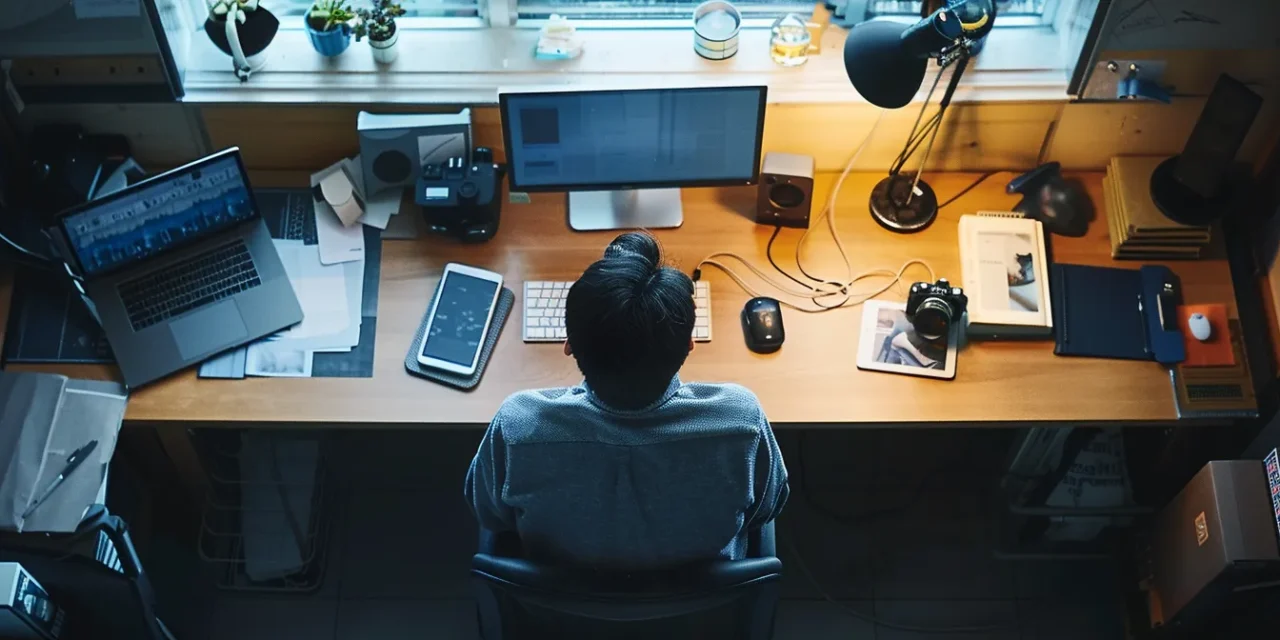Table of Contents
ToggleTable Of Contents:
- Achieving Harmony in Your Internet Life Balance
- Key Takeaways
- Establishing Clear Boundaries Between Online and Offline Life
- Identify Your Most Frequent Online Activities
- Set Specific Times for Checking Social Media and Emails
- Allocate Offline Periods During Your Day
- Use Technology to Remind You to Take Breaks
- The Importance of Unplugging for Mental Health
- Understand How Constant Connectivity Affects Your Well-Being
- Practice Mindfulness to Reduce Online Distractions
- Reflect on Your Feelings and Productivity After Offline Periods
- Integrating Mindful Internet Use Into Daily Life
- Start With a Purpose for Your Online Activity
- Limit Multitasking to Enhance Focus
- Prioritize Tasks That Align With Your Goals
- Regularly Review and Adjust Your Online Habits
- Tools and Apps to Support Your Internet Life Balance
- Explore Apps That Track and Limit Screen Time
- Use Website Blockers to Minimize Distractions
- Set Up Automatic Reminders for Breaks
- Discover Tools That Promote Relaxation and Offline Activities
- Conclusion
Achieving Harmony in Your Internet Life Balance
Amid the ceaseless hum of notifications and the ever-present lure of a new browser tab, meditation becomes a quiet rebellion against the digital tide. Engaging in regular conversation with peers about the risk of internet overuse can spark a collective vigilance. Studies from esteemed universities suggest that our brains might even start to mistake the language of emojis for genuine human interaction. To safeguard our mental well-being, it is essential to establish a sanctuary apart from the online buzz. In this article, I’ll share practical strategies and tools that can help you cultivate a healthier relationship with the internet.
Key Takeaways
- Deliberate boundaries between online and offline enhance presence and well-being
- Designated times for digital activities can greatly improve mental focus and productivity
- Mindfulness practices contribute to better cognitive function and inner peace
- Monitoring and managing screen time is vital for a balanced lifestyle
- Automation and intentional communication shape a productive, goal-oriented online engagement
Establishing Clear Boundaries Between Online and Offline Life
In pursuit of a serene equilibrium between the online whirlwind and the tranquility of our offline existence, I’ve come to realize that the key lies in setting deliberate boundaries. For many of us, the line between digital engagement and real-world interactions has become blurred, fostering a persistent feeling of being tethered to our devices. It begs the question, how often do we allow our online activities to encroach upon moments that should be spent present in the physical world? Personally, the journey starts with scrutinizing my most frequent virtual haunts: the social platforms, streaming services, and the incessant ping of incoming emails. By earmarking specific windows of time strictly for online correspondence and social scrolls, I reclaim chunks of my day for true, undisturbed engagement with life beyond the screen. It’s about penciling in those vital offline interludes and leveraging the very technology that binds us—a reminder on our telephone—to prompt us away from the screen. As someone invested in continual education, both digital and personal, I believe it’s the synthesis of structured online engagement with the wisdom derived from offline experiences that enriches our knowledge and nourishes well-being.
Identify Your Most Frequent Online Activities
As I scrutinize my online footprint, pinpointing my most frequent digital interactions becomes an exercise of introspection. I’ve observed the infrastructure of my day-to-day life, unhappily interwoven with an algorithm-driven addiction to scrolling, which increasingly dictates not only my actions but also my thoughts and feelings. Comprehending the hold that this cycle has on me is the first stride towards achieving a more harmonious internet life balance, one where I can engage with digital culture without losing my grounding in the physical world.
- Evaluating my dependency on algorithm-curated content.
- Examining the time spent on various social media platforms.
- Acknowledging the pull of streaming services and the impact on my offline interactions.
- Assessing email habits that contribute to technology tethering.
Set Specific Times for Checking Social Media and Emails
As part of the delicate dance between digital and personal worlds, I’ve learned the benefits of confining my social media and email engagement to specific, predetermined slots during the day. This adopted behavior, deeply rooted in the understanding of our own psychology, ensures that my attention isn’t divided during crucial family time or even during breaks like holidays. It took a considerable shift to resist the habit of aimlessly checking messages on my laptop, but the payoff in terms of productivity and peace, whether in personal or employment spheres, has been profound.
| Activity | Designated Time Slot | Expected Benefit |
|---|---|---|
| Social Media Checking | Morning: 8 AM – 9 AM | Stay informed with a clear mind. |
| Email Correspondence | Afternoon: 2 PM – 3 PM | Efficient communication with colleagues. |
| Entertainment Streaming | Evening: 7 PM – 9 PM | Relax and unwind after the day. |
Allocate Offline Periods During Your Day
In the relentless pursuit to maintain a healthy balance, designating offline periods within my daily routine serves as a bulwark against the creeping anxiety that digital overload can precipitate. It’s during these precious offline windows that I immerse myself in the physical realm – whether it’s through a yoga session that refocuses my mind, or simply stepping outside to breathe in fresh air, these actions help reinforce a more grounded and authentic sense of self, one that isn’t skewed by the image and pressure perpetuated by online narratives. Embracing these breaks is more than an exercise in self-control; it’s a statement of motivation and a commitment to personal well-being:
- Engaging in yoga to fend off screen-induced anxiety.
- Seeking activities that bolster a genuine self-image, devoid of digital pressures.
Use Technology to Remind You to Take Breaks
In harnessing the same technology that often binds us to screens, we can judiciously use data to track usage patterns and prompt necessary breaks. My mobile phone, a constant companion, now doubles as a mindful guardian—its alarms and notifications serve as gentle nudges to step away, to mitigate the risk of digital fatigue and protect my health. Encouragements rooted in apps, many of which are developed with insights from institutions like Stanford University, are daily reminders to disconnect and recharge in the real world.
Recognizing the distinct spaces our digital habits occupy is just the beginning; what unfolds next is the transformative power of disconnecting. Let’s delve into how stepping away from the screen can rejuvenate our mental well-being.
The Importance of Unplugging for Mental Health

Striking a balance between my constant connectivity and maintaining sound mental health often presents a challenge. Regular exposure to the whirlwind of innovation and interaction across platforms can overwhelm the brain, leading to fatigue. In my journey toward a healthier lifestyle, I’m learning to appreciate the quiet moments as much as the bustling digital ones, particularly here in Latin America where the rhythms of life play beautifully alongside technological advancement. I’ve begun incorporating apps that are designed with mindfulness in mind, assisting me in becoming more intentional in how and when I use the internet. To truly gauge the influence of these strategies, reflection on my feelings and productivity after dedicated offline periods has become a cornerstone of my daily routine, allowing me to assess their effect on my well-being.
Understand How Constant Connectivity Affects Your Well-Being
As a chief information officer, my reality is deeply intertwined with the online ecosystem, negotiating policies and overseeing digital operations. Yet, amid the convenience and necessity of functions like online shopping, I’ve embarked on a personal experiment, observing the subtle shift in my well-being as I tailor my connectivity. Stepping back from the ceaseless stream of data has mitigated feelings akin to chronic disease, where constant engagement had left me mentally fatigued and less receptive to the nuanced ebbs and flows of life.
Practice Mindfulness to Reduce Online Distractions
My ventures into mindfulness, specifically designed to combat the stress associated with constant “facetime” on various platforms, have proven to be integral in curbing the distractions that broadband connectivity often presents. As I incorporate mindful practices, I notice a significant shift in my day: a serene focus replaces what used to be a cacophony of relentless notifications and digital demands.
- Engaging in short, guided meditation sessions each morning to establish a tranquil mindset for the day.
- Allocating moments for deep breathing exercises before responding to work emails, which allows for thoughtful communication.
- Practicing mindful eating during lunch, away from screens, to savor the flavors and nourish the body and mind.
This shift is firmly rooted in science, demonstrating a correlation between mindfulness techniques and improved cognitive function. Embracing this knowledge, I view myself as an engine converting technological chaos into harmonized living. Transitioning from multitasking to mono-tasking, whenever possible, is just one powerful stride I take toward enhanced mental clarity and well-being.
Reflect on Your Feelings and Productivity After Offline Periods
Gathering information on the effects of scheduled offline periods, particularly during remote work, has been enlightening for my mind and overall productivity. Reflecting on my state after disconnecting, I find data that resonates with findings from the Pew Research Center: a monitored break from educational technology and persistent connectivity significantly sharpens my cognitive abilities.
| Time Frame | Activity | State of Mind Before | State of Mind After |
|---|---|---|---|
| 1 week | Daily 2-hour offline break | High stress, low focus | Clear, composed |
| 2 weeks | Weekend digital detox | Overwhelmed, fatigued | Rejuvenated, productive |
| 1 month | Weekly offline day | Distracted, less creative | Concentrated, innovative |
Embracing moments disconnected from our devices leads to a revitalized mind, ready to engage with the world more consciously. Let’s consider practical strategies to weave mindful internet use into the fabric of our everyday routines.
Integrating Mindful Internet Use Into Daily Life
In my quest to cultivate a balanced internet life, I’ve observed that approaching online activities with intention, akin to a carefully choreographed dance, is paramount. Whether it’s using sophisticated software to streamline tasks, crafting a marketing strategy, or fostering connections in a digital community, purpose drives my engagement. On my computer, multitasking takes a back seat to focused action that aligns closely with my aspirations. By consistently evaluating and fine-tuning my digital practices, I maintain this rhythm, ensuring that every click, swipe, and keystroke propels me toward my goals rather than away from them.
Start With a Purpose for Your Online Activity
Embarking on online endeavors requires a proactive and intentional approach; I treat my device not merely as a portal for passive consumption but as a powerful tool for active engagement. By focusing on a purposeful use before I even unlock my screen, I ensure my time spent online is conducive to learning and personal growth, thereby safeguarding my mental wellness. This outlook transforms my devices from potential distractions into enablers of knowledge and self-improvement.
- Approaching online sessions with definitive objectives
- Utilizing digital tools for enhancement rather than mere entertainment
- Employing internet time to foster learning and mental expansion
Limit Multitasking to Enhance Focus
In the landscape of cloud computing and the ever-connected world, I’ve embraced the exercise of channeling my focus into a singular task amidst a sea of digital potential. Shifting away from the habitual pull of social media apps and online chatter, I’ve witnessed a marked improvement in both my mental sharpness and the quality of my work output, proving that organization of thought is just as critical as organization of time when navigating the boundless avenues of the internet.
Prioritize Tasks That Align With Your Goals
In my relentless quest for balance within the digital world, I’ve adopted automation as a silent ally. By delegating repetitive tasks to software, I clear space for high-value work that’s directly tied to my goals. The efficiency of automation ensures that more of my time is spent on strategic initiatives rather than the mundane, allowing me to harness the full potential of the world wide web.
Conscious prioritization in the digital realm has also led to modifying my communication habits. Instead of allowing frequent Skype calls to scatter my focus, I schedule them judiciously, aligning each meeting with my larger objectives. This switch not only refines my productivity but also enhances the meaningful use of my digital tools.
Regularly Review and Adjust Your Online Habits
Continually reassessing my interaction with digital media is an essential part of my media-conscious lifestyle, keeping the scales balanced between online and real-world engagements. Recognizing when certain apps contribute more to fear and anxiety than to productivity prompts me to adjust my usage or remove them altogether. It’s through this ongoing process of evaluation and adaptation that I ensure my presence in the digital realm supports rather than disrupts my well-being.
Now, as we focus on infusing mindfulness into our digital routines, let’s shift our attention to practical resources. Discover the tools and applications specifically designed to help maintain a harmonious balance between your online and offline worlds.
Tools and Apps to Support Your Internet Life Balance

Navigating the digital landscape can significantly impact productivity if not approached with deliberation and intelligence. Working towards a desirable balance often necessitates the assistance of modern tools that aid us in aligning our online presence with our daily goals. Acknowledging that adequate sleep, exercise, and free time are as vital as any email, I capitalize on apps devised to monitor and curtail screen time. Website blockers emerge as valuable allies, sophisticated enough to quell the siren calls of distraction. As someone in constant pursuit of optimal performance, I integrate automatic reminders, ensuring regular breaks from the glare of screens, crucial for maintaining a focused and collaborative spirit. Exploring the expansive array functional tools propels me toward a richer existence – one punctuated by periods of interaction and solitude, each enhancing the other. Cultivating a harmonious blend of connectivity with intentional disconnection, I turn to innovations that foster relaxation and promote activities away from digital devices, ultimately supporting a well-rounded and health-conscious lifestyle.
Explore Apps That Track and Limit Screen Time
In our digital age, the distinction between online and offline can often become indistinct, leaving us swimming in an ocean of hours spent tethered to devices. Exploring apps designed to monitor and regulate screen time is a step toward regaining control and restoring balance to our digital life. These applications embody the precision and care we digest in other areas such as customer relationship management, quantifying and corralling our digital consumption.
- Identifying apps that provide accurate tracking of active screen usage.
- Setting actionable limits that align with personal goals for online and offline harmony.
- Using these insights to inform and adjust our digital behaviors for a healthier lifestyle.
Use Website Blockers to Minimize Distractions
My venture into a harmonized internet existence led me to incorporate website blockers, a strategic part of my life management toolkit. After conducting thorough research, I adopted this technology to curb the automatic habit of falling into the rabbit hole of social media and other distractions. Now, my focus remains sharp, and these moments of indulgence are chosen, not stumbled upon.
Set Up Automatic Reminders for Breaks
Embracing digital technology has its advantages, yet, without question, it requires us to manage our screen time to sustain productivity and well-being. By setting automatic reminders to take breaks, the persistent pull on our attention can be redirected. This practice, supported by the company I work for through the integration of RSS feeds for timely notifications, is now a staple in my routine, helping to compartmentalize and control my digital engagement.
Discover Tools That Promote Relaxation and Offline Activities
In my pursuit of mastering the delicate act of disconnecting, I have found solace in innovative technologies specifically geared towards fostering relaxation. Across North America, I’ve leveraged apps that encourage digital detox by securing my smartphone away through a password-protected time-out feature, allowing me to immerize myself in the tangible joys of my surroundings without the magnetic pull of constant connectivity. Solely based on user feedback, many of these tools have seen widespread adoption in the United Kingdom as well, signifying a shared desire for intentional breaks from our bustling online worlds.
Conclusion
Achieving a harmonious internet life balance requires setting clear boundaries, which protects our mental health from the strains of constant connectivity. By deliberately scheduling online activities and adopting offline periods, we cultivate a focused mind and enhance our productivity. Regular reflection and the strategic use of apps to monitor and regulate digital engagement enable us to maintain control over our screen time. These practices ensure our internet use is intentional and conducive to a well-rounded, wellness-oriented lifestyle.





